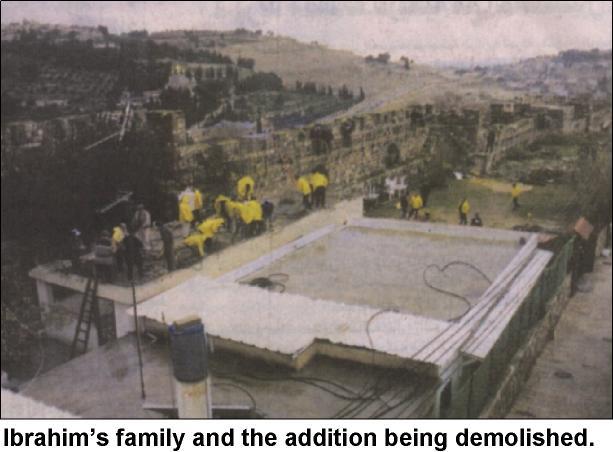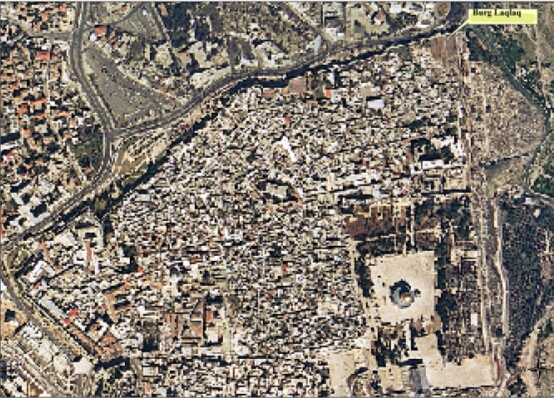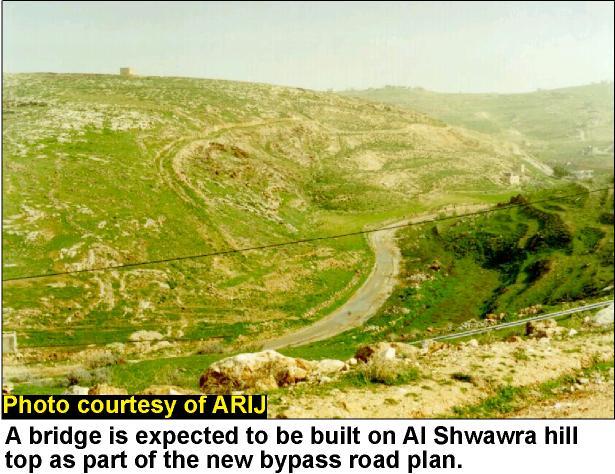Background to the new violation
Type of violation: demolition of a housing unit
Type of construction: an addition to an old Palestinian house . The total area of the destroyed addition is 70 square meters. It served as a housing unit for a Palestinian family.
Name of owner: Mohammed Yaser Shaker Ibrahim, 34 years old.
Demolition justification: Building without license.
Number of family members: three ( including husband, wife and five and half years-old daughter).
Date of construction: 1999
Date of demolition: 21/1/2002
Demolition circumstances
The son marries and adds a housing unit:
The family of Ibrahim has been living in an old house located in Burj Laqlaq since many generations (See picture). As the family was getting bigger, Mohammed, who got married in 1996, was obliged to add one room, a small hall, a kitchen and water circle with a total area of 70 square meters to his father's house. Mohammed did this to reduce overcrowding in his father's house which was inhabited by 18 persons at that time. Of course, he added the extension without obtaining a building license from the Municipality after he had failed to get one despite all the efforts he exerted in this regard. The refusal to give him a permit was part of the Israeli policy denying the Palestinians right to build or renovate houses in Jerusalem while, at the same time, giving the Israeli settlers all the encouragement and incentives to do so.
The municipality asks the owner to demolish his house by his own hands. In an interview with LRC field worker, Mohammed gave the following account: 'The municipality had earlier sent me a warning asking that I had to demolish the house by my self. This house was the only shelter to live in with my wife and daughter. When I refused to follow suit, about 15 police and army officers came to my house on January 20th, a day before the actual demolition was carried out, and started to inspect the flat and take pictures of it. Then, I realized that the demolition was approaching, especially after the lawyer's attempts to get license went in vain'.
The demolition performed
On Monday, January 21st, 2002, at 6:00 AM, large numbers of Israeli military and police forces (estimated at 500 members) closed all the roads and entrances leading to Burj Laqlaq area and prevented citizens from approaching. Some soldiers took to the roofs of the houses and climbed the walls of the old city, while Romanian workers hired by the municipality started to evacuate the furniture from the flat.
The workers used manual demolition and digging tools in their attack against the flat. The demolition process lasted for almost three hours.
In another interview with LRC field worker, Mohammed's wife said whilst crying: ' They are monsters who have no mercy. They destroyed the whole structure and raised it to the ground. This crime was carried out by more than 500 personnel in front of our eyes. We were unable to do any thing to stop it'.The owner has to pay wages for the destroyers
After the demolition process was completed, the municipality imposed a fine of 10 000 NIS on the owner as wages for the workers who knocked down his house. This measure is viewed by the owner as a financial punishment because he refused an early municipality notice to demolish the house by himself.
More demolition orders
Owners of three houses situated in the same area recently received notices similar to the one received by Mohammed in which the municipality asked them to demolish their houses on their own. Otherwise, they had to face the same situation as Moahmmed's.
The three owners are:
1. Asa'd Sharif;
2. Hazem Sharif;
3. Shaker Salim, the grandfather of Mohammed whose house is under discussion in this case study.
The three threatened houses are amongst a new list of ten houses all located in Burj Laqlag and planned to be demolished by the municipality.
Israeli greeds in Burj Laqlaq
Site importance
Burj Laqlaq area is located in the north eastern corner of the old city of Jerusalem ( See map). It is part of the densely populated Islamic quarter. The total area of Burj Laqlaq is 10 dunums, surrounded by Bab Al- Asbat (Lions Gate) in the eastern part of the wall and Bab Al- Zahera (Herod's Gate) in the northern part of the wall. The area over looks the Haram Al- Sharif compound to the south, Rockfeller museum to the north and the Mount of Olives and Mount Scopus to the east. See map
Map of the old city
Israeli plans
The Israeli ministries of Infrastructure and Antiquities upon decision from smaller cabinet started a wide scale excavation campaign at the site looking for Jewish objects. This process entails the demolition of ten Palestinian houses as mentioned above ( three of the owners already received notices and one flat demolished ).
This plan was directly drawn-up by the current minister of Tourism Bani Ayalon who is considered the chief supporter of Jewish extremist colonization groups headed by Ateret Kohanim which persistently try to get foot holds in every corner of the old city. So far, its members managed to seize dozens of homes and properties in 60 locations in the Muslim, Christian and Armenian quarters of the old city.
The on-going excavation campaign came as a preliminary step towards the establishment of at least 200 housing units for exclusive Jewish use in Burj Laqlaq area. Ariel Sharon, who was the minister of Housing at the time, decided this construction plan in 1990. The plan aims at controlling this sensitive area and the two most important gates of the old city, Bab Al -Asbat ( Lions Gate) and Bab Al- Azahera ( Herod's Gate).
This Israeli project is considered, in particular, a penetration of the Islamic quarter which is relatively free of colonization nuclei. It is, also, sensitive in two ways: firstly, in strengthening security in the old city and, secondly, in bringing between 500-600 settlers into the old city which, consequently, will create a demographic change in Bab Huta neighborhood for the benefit of Israeli settlers.
In case this project was completed, it will form the second largest colonialist block in the old city after Maghareba ( Moroccan ) quarter or uta for the benefit of Hu(also known as the Jewish quarter).
AWaqf land
The Islamic Awqaf (Endowment affairs) authorities in Jerusalem confirmed that the Burj Laqlaq land is totally waqf land and contains Islamic and Byzantine antiquities. The Israeli government prevents Palestinians from building, renovating or extending already existing houses in the area under the pretext that the land is an archeological site. In the mean time, the Israeli authorities destroyed large areas of archeological importance to make room for the construction of Jewish quarters as had happened in Maghareba ( Moroccan ) quarter of the old city right after the 1967 war.
Two previous demolitions
On 26/8/1996, Jerusalem municipality demolished the only center for Palestinian disabled in the old city, which was built in Burj Laqlaq by Canadian government funding. During the demolition process, municipality bulldozers also destroyed the children's playground. In 1996, the municipality demolished a house at the same location belonging to the family of Iljawi.
Israeli greed in the old city
Ever since its occupation of the city of Jerusalem in 1967, Israel has been working very hard to get hold of as much space in the old city as possible. This policy has been going on in order to build houses for Israeli settlers with the aim of achieving a Jewish majority or at least reaching demographic parity with Palestinians.
Hence, and immediately after 1967 occupation, Israeli authorities performed the biggest demolition campaign against Palestinian homes and properties in the Old City. The Israelis destroyed the Maghareba ( Moroccan ) quarter in the south western side of Al- Haram Al- Sharif. They conducted this campaign to create space for the construction of the 'western wall plaza'. At least 200 houses and one mosque were razed to the ground as a result of the aforementioned demolition process.
Ten years after this crime, the Israelis completely controlled Maghareba ( Moroccan ) quarter and made more than 90 Palestinian families homeless. In addition, they dismissed 10 families in Qirmi quarter, 5 in Khaldi quarter and Bab Silsila. 17 other Palestinian houses were also confiscated by the orders of the Israeli military governor and were re-used for security and military purposes. Moreover, other Palestinian properties were seized in Aqabat Khaldiya, Hush Al- Shawish, Aqabat Saraya, Sa'diya quarter, Bab Huta and Christian quarter.
Over the period of 34 years, the Israelis managed to seize 550 Palestinian houses in the old city of Jerusalem, including the house of current Israeli premier Ariel Sharon in Al- Wad Street. The number of Israeli settlers in the old city is 3000 versus 49000 Palestinians Muslims, Christians and Armenians ( Statistics of Jerusalem Center for Women).
Different measures to seize Palestinian houses and properties in old Jerusalem
In addition to armed military force, the Israelis use other measures and tools to seize Palestinian houses and properties, including the following:
- The use of some legal entries and exploitation of weaknesses in the standing law such as the absentee property law and antiquities law.
- The use of direct attacks to seize houses. Mostly, such attacks are carried out by members of extremist religious groups like Ateret Kohanim under official military protection.
- The prevention of Palestinians from renovating their old and shaky houses as an introduction to total seizure. That is, the Israeli would come and say that the houses have been insecure and improper for human life. Eventually, most of these houses face demolition without giving their owners any other practical alternatives.
- The prevention of any constructions of new Palestinian houses or any additions to already existing houses in the old Jerusalem.
- The intensification of Jewish construction, both horizontally and vertically, inside the walls of the old city. This process is synchronized with the bringing in of large numbers of Israeli settlers, especially the extremist ones.
Goals of Israeli policy in old Jerusalem
- To empty the city from its Palestinian inhabitants;
- To judaize the city by bringing further numbers of Jewish settlers;
- To destroy any future possibility of Palestinian sovereignty over Jerusalem;
- To guarantee the continuation of Jerusalem, at least from the Israeli point of view, as the ' eternal unified capital of Israel';
- To build the third temple.
Human rights position
- The Fourth Geneva Convention prohibits the occupying power from transferring its citizens to the occupied land, and prohibits the destruction of properties and violating human rights ( article 11).
- The UNESCO agreements and declarations prohibit the occupation authorities from making any changes on the ground in the architectural, cultural and traditional heritage of the occupied people.
- The international agreement on the rights of housing calls for guaranteeing proper housing conditions for human beings.
- International agreements and covenants forbid the dispossession of private properties of humans.
Prepared by
The Land Research Center
LRC
















